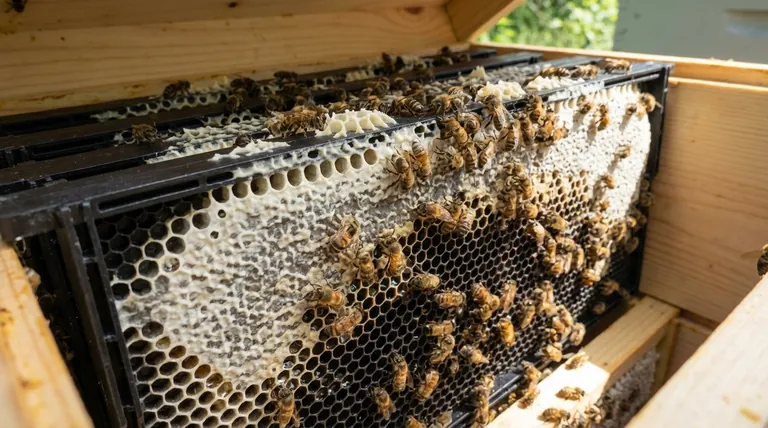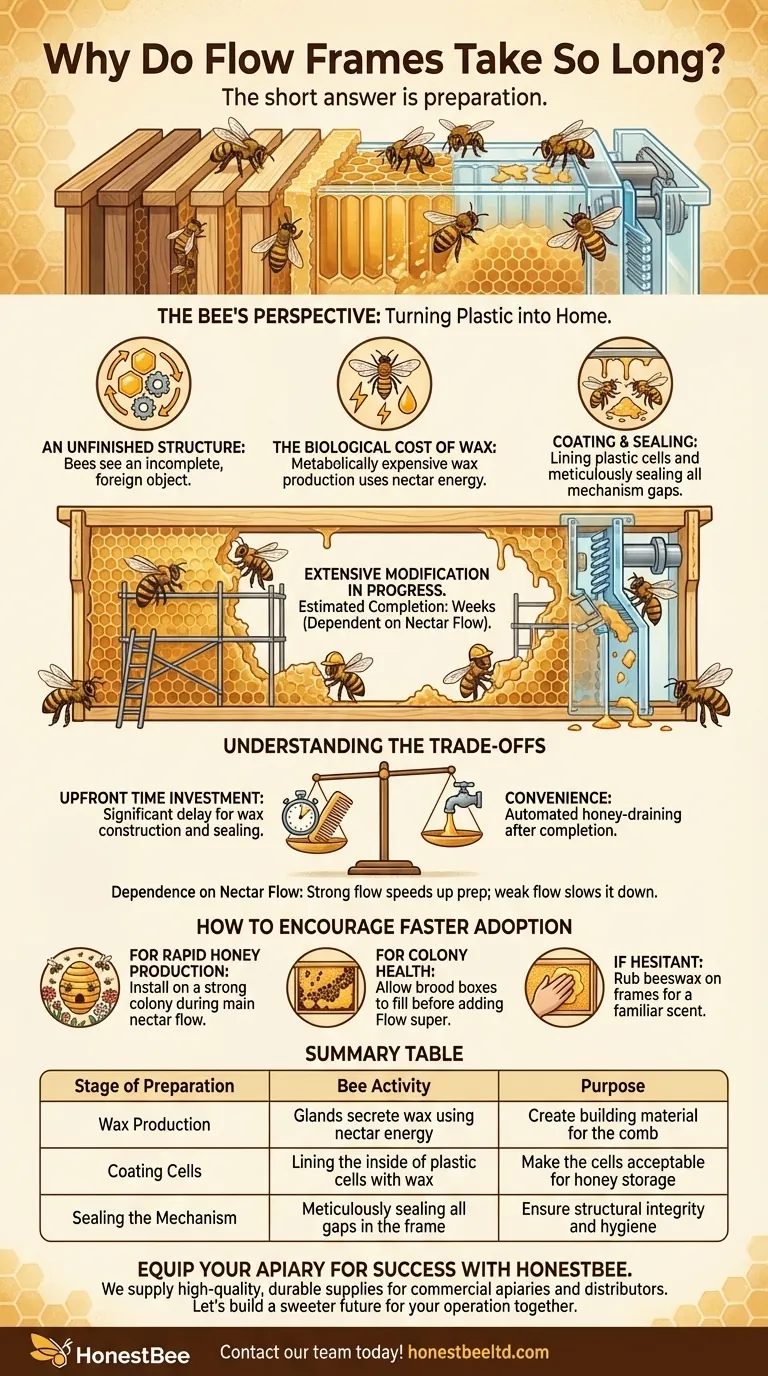The short answer is preparation. Flow Frames take a long time to be filled because the bees must first complete a significant amount of construction work. They have to produce their own wax to coat every plastic cell and meticulously seal all the tiny gaps in the frame’s honey-draining mechanism before they will begin storing honey.
The delay you're observing is not a flaw but a fundamental part of the bees' natural process. Before they can use the Flow Frames for honey storage, the bees must first invest considerable time and energy to modify the artificial structure into something they recognize as a secure part of their honeycomb.

The Bee's Perspective: Turning Plastic into Home
To understand the delay, we must first see the Flow Frame from the colony's point of view. It arrives as an incomplete, foreign object that requires extensive modification.
An Unfinished Structure
Bees are instinctively driven to create a perfect, sealed environment. A new Flow Frame is full of gaps and coated in a material (plastic) they did not create.
They will not store their precious winter food supply in a structure until they have finished it to their own exacting standards.
The Biological Cost of Wax
As the reference material notes, bees must produce wax using glands on their bodies. This is a metabolically expensive process.
It requires a large amount of energy, which the bees derive directly from the nectar they collect. This diverts resources that could otherwise have been turned into honey.
Coating the Cells
The first major task is to line the inside of the pre-formed plastic cells with a thin layer of their own beeswax. This coating makes the cells acceptable to the bees for honey deposition.
Sealing the Mechanism
The most time-consuming step is sealing the complex Flow Frame mechanism. The frame is designed to split apart to let honey out, which means it is constructed of many individual, moving parts.
The bees must find and seal every single one of these hair-line gaps with wax to ensure the structural integrity and hygiene of their comb. This is detailed, painstaking work that can take weeks.
Understanding the Trade-offs
The convenience of the Flow Hive system comes with an upfront time and energy investment that is handled entirely by the bees. Understanding this trade-off is critical for managing your expectations.
The Upfront Time Investment
The primary trade-off is the significant delay at the beginning of the season (or the first time the frames are used). This is the period when the bees are doing all the required wax construction.
Traditional frames, where bees draw out their own comb on a simple foundation, also require time. However, the complex mechanism of a Flow Frame adds a unique and lengthy "sealing" phase to the process.
Dependence on Nectar Flow
Because wax production is fueled by nectar, the entire process is highly dependent on the environment.
If there is a strong nectar flow, the bees have abundant resources and will complete the prep work more quickly. During a weak flow, they will prioritize feeding themselves and the brood, and work on the Flow Frames will slow or stop completely.
How to Encourage Faster Adoption
You cannot force the bees, but you can create conditions that encourage them to adopt the frames more quickly. Your approach should depend on your primary goal.
- If your primary focus is rapid honey production: Install the Flow super on a very strong, populous colony right as the main nectar flow in your area begins.
- If your primary focus is colony health: Allow a new or weaker colony to fully build out its brood boxes before adding the Flow super, even if it means waiting a full season.
- If your bees seem hesitant to enter the super: You can encourage them by rubbing a small amount of beeswax onto the frames to provide a familiar scent and starting point.
Patience is key; the bees are working according to a natural process that cannot be rushed.
Summary Table:
| Stage of Preparation | Bee Activity | Purpose |
|---|---|---|
| Wax Production | Glands secrete wax using nectar energy | Create building material for the comb |
| Coating Cells | Lining the inside of plastic cells with wax | Make the cells acceptable for honey storage |
| Sealing the Mechanism | Meticulously sealing all gaps in the frame | Ensure structural integrity and hygiene |
Equip Your Apiary for Success with HONESTBEE
Understanding the natural processes of your bees is key to a successful harvest. At HONESTBEE, we supply commercial apiaries and beekeeping equipment distributors with the high-quality, durable supplies needed to support healthy, productive colonies. Whether you're managing Flow Hives or traditional setups, our wholesale-focused operations ensure you get the reliable equipment your business depends on.
Let's build a sweeter future for your operation together. Contact our team today to discuss your needs!
Visual Guide

Related Products
- Plastic Bee Frame Beekeeping Hive Frames for Wholesale
- Assembled Wooden Bee Frames with Beeswax Foundation Ready to Use by HONESTBEE
- HONESTBEE Wired and Assembled Wooden Bee Frames Foundation for a Thriving Hive
- Professional 500g Sectional Comb Honey Frame System for Beekeeping
- 7 x Auto Bee Flow Hive Frames Plastic Beekeeping Hive Box Supplies
People Also Ask
- Are plastic bee hive frames good? A Guide to Modern Durability vs. Natural Appeal
- What is the role of oxalic acid in plants? A Key to Plant Defense and Internal Regulation
- What are the differences between wooden and plastic frames in beehives? Choose the Best for Your Apiary
- Can beekeepers switch between wooden and plastic frames? Optimize Your Hive's Performance
- Why are plastic frames popular in commercial beekeeping? Boost Efficiency & Durability at Scale



















